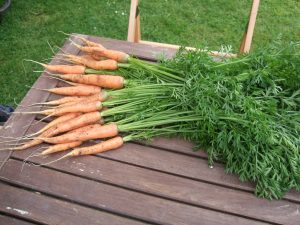
Thinning from the crop of F1 carrot ‘Fly Away’ showing how succesful this particular sowing has been.
New interpretation panels have been installed to help explain the purpose of the Really Wild Veg growing trials across four gardens in Scotland. At the Botanics the panels are in the Demonstration Garden and in the planters on the decking outside the John Hope Gateway Building.
The aim of the project is to explore how domestication has changed familiar crops by growing them alonside their native Scottish wild relatives. A particular focus is being placed upon potential changes to nutritional quality and this is being explored by the Rowett Institute of Nutrition and Health.
The crops in the trials are now becoming well-established thanks to plenty of warm weather and a reasonable amount of rain.
Problems with pests have been reported in a number of cases, and this highlights the value of having multiple plots across more than one garden. Hermitage Vegetable Garden in Edinburgh has unfortunately lost all of the wild cabbage to slug damage, but the carrots that were slow to get going are now doing well.
At Cruickshank Botanic Garden the brassica bed had to be netted at the end of June to prevent pigeon damage. We find this is essential at the Botanics and we generally net brassicas as soon as they are planted in the ground.
Our heritage carrots had a hard time with vine weevil and many gaps are now present in the crop. As the carrots at the Botanics are being grown in planters it will be useful to try to find out if the vine weevil problem is a legacy of what was in the planters last year, or whether the heritage variety has proved to be more attractive to vine weevils. In such a small experiment it is often hard to be confident about the cause behind observations. In this case knowing when vine weevils lay their eggs will probably shed ligt on the question. The thinning from the F1 carrots produced a nice crop of baby carrots in early July.

